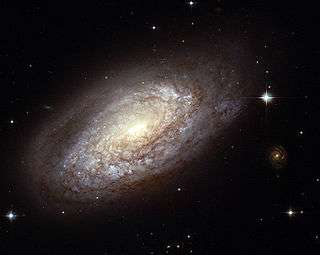NGC 2397
| NGC 2397 | |
|---|---|
|
NGC 2397 | |
| Observation data (J2000 epoch) | |
| Constellation | Volans |
| Right ascension | 07h 21m 19.997s[1] |
| Declination | −69° 00′ 5.46″[1] |
| Redshift | 0.004546[1] |
| Distance | ca. 60 Mly[2] |
| Apparent dimensions (V) | 2.5′ × 1.2′[1] |
| Apparent magnitude (V) | 12.68[1] |
| Other designations | |
| NGC 2397, PGC 20766 | |
NGC 2397 is a classic spiral galaxy, located in the Volans constellation. It is about 60 million light-years from Earth.[2] The nucleus consists of older yellow and red stars; more recent stars have formed within the outer blue spiral arms, which also feature protrusions of dust.[3]
John Herschel discovered the galaxy on February 21, 1835.[4] In March 2006, a star in the galaxy, SN 2006bc, was spotted in the late stages of supernova.[2] Astronomers at Queen's University Belfast, who have been studying supernovas to find out what sort of stars explode, worked through previously captured images of the galaxy and found one of when the star exploded, one of only six ever collected.[5]
References
- 1 2 3 4 5 "NASA/IPAC Extragalactic Database". Results for NGC 2397. Retrieved November 24, 2011.
- 1 2 3 "Exploding star in NGC 2397". Hubble. 31 March 2008. Retrieved 24 November 2011.
- ↑ "Exploding star in nearby galaxy". European Space Agency. 1 April 2008. Retrieved 29 November 2011.
- ↑ "NGC Objects: NGC 2350 - 2399". Retrieved 30 November 2011.
- ↑ O'Neill, Ian (April 5, 2008). "Supernova Precursor Discovered in Spiral Galaxy NGC 2397". Universe Today. Retrieved 1 December 2011.
External links
| ||||||||||
This article is issued from Wikipedia - version of the Wednesday, January 27, 2016. The text is available under the Creative Commons Attribution/Share Alike but additional terms may apply for the media files.
